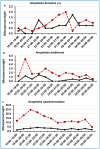Species Composition, Seasonal Abundance, and Biting Behavior of Malaria Vectors in Rural Conhane Village, Southern Mozambique
- PMID: 36834293
- PMCID: PMC9966379
- DOI: 10.3390/ijerph20043597
Species Composition, Seasonal Abundance, and Biting Behavior of Malaria Vectors in Rural Conhane Village, Southern Mozambique
Abstract
Malaria vector surveillance provides important data to inform the effective planning of vector control interventions at a local level. The aim of this study was to determine the species diversity and abundance, biting activity, and Plasmodium infectivity of Anopheles mosquitoes from a rural village in southern Mozambique. Human landing catches were performed monthly between December 2020 and August 2021. All collected Anopheles were identified to the species level and tested for the presence of malaria parasites. Eight Anopheles species were identified among the 1802 collected anophelines. Anopheles gambiae sensu lato (s.l.) were the most abundant (51.9%) and were represented by Anopheles quadriannulatus and Anopheles arabiensis. Anopheles funestus s.l. represented 4.5%. The biting activity of An. arabiensis was more pronounced early in the evening and outdoors, whereas that of An. funestus sensu stricto (s.s.) was more intense late in the night, with no significant differences in location. One An. funestus s.s. and one An. arabiensis, both collected outdoors, were infected with Plasmodium falciparum. The overall entomologic inoculation rate was estimated at 0.015 infective bites per person per night. The significant outdoor and early evening biting activity of An. arabiensis and An. funestus found in this village may negatively impact the effectiveness of current vector control interventions. Additional vector control tools that can target these mosquitoes are needed.
Keywords: Anopheles; Mozambique; feeding behavior; seasonal abundance.
Conflict of interest statement
The authors declare no conflict of interest. The funders had no role in the design of the study; in the collection, analyses, or interpretation of data; in the writing of the manuscript; or in the decision to publish the results.
Figures




Similar articles
-
Changes in contributions of different Anopheles vector species to malaria transmission in east and southern Africa from 2000 to 2022.Parasit Vectors. 2023 Nov 7;16(1):408. doi: 10.1186/s13071-023-06019-1. Parasit Vectors. 2023. PMID: 37936155 Free PMC article. Review.
-
Differences in malaria vector biting behavior and changing vulnerability to malaria transmission in contrasting ecosystems of western Kenya.Parasit Vectors. 2023 Oct 21;16(1):376. doi: 10.1186/s13071-023-05944-5. Parasit Vectors. 2023. PMID: 37864217 Free PMC article.
-
Persistently high estimates of late night, indoor exposure to malaria vectors despite high coverage of insecticide treated nets.Parasit Vectors. 2014 Aug 20;7:380. doi: 10.1186/1756-3305-7-380. Parasit Vectors. 2014. PMID: 25141761 Free PMC article.
-
Anopheles rufipes implicated in malaria transmission both indoors and outdoors alongside Anopheles funestus and Anopheles arabiensis in rural south-east Zambia.Malar J. 2023 Mar 16;22(1):95. doi: 10.1186/s12936-023-04489-3. Malar J. 2023. PMID: 36927373 Free PMC article.
-
Biting patterns of malaria vectors of the lower Shire valley, southern Malawi.Acta Trop. 2019 Sep;197:105059. doi: 10.1016/j.actatropica.2019.105059. Epub 2019 Jun 10. Acta Trop. 2019. PMID: 31194960
Cited by
-
Bionomics and distribution of malaria vectors in Kisumu city, Western Kenya: implications for urban malaria transmission.Malar J. 2025 Mar 15;24(1):85. doi: 10.1186/s12936-025-05332-7. Malar J. 2025. PMID: 40089759 Free PMC article.
-
Changes in contributions of different Anopheles vector species to malaria transmission in east and southern Africa from 2000 to 2022.Parasit Vectors. 2023 Nov 7;16(1):408. doi: 10.1186/s13071-023-06019-1. Parasit Vectors. 2023. PMID: 37936155 Free PMC article. Review.
-
The bionomics of Anopheles arabiensis and Anopheles funestus inside local houses and their implications for vector control strategies in areas with high coverage of insecticide-treated nets in South-eastern Tanzania.PLoS One. 2024 Dec 5;19(12):e0295482. doi: 10.1371/journal.pone.0295482. eCollection 2024. PLoS One. 2024. PMID: 39637234 Free PMC article.
-
Malaria transmission heterogeneity in different eco-epidemiological areas of western Kenya: a region-wide observational and risk classification study for adaptive intervention planning.Malar J. 2024 Mar 12;23(1):74. doi: 10.1186/s12936-024-04903-4. Malar J. 2024. PMID: 38475793 Free PMC article.
-
Assessing Anopheles species collection techniques in a low malaria transmission area: implications for vector surveillance and control.Malar J. 2025 Jul 1;24(1):204. doi: 10.1186/s12936-025-05463-x. Malar J. 2025. PMID: 40597339 Free PMC article.
References
-
- World Health Organization . WHO Guideline for Malaria, 13 July 2021. World Health Organization; Geneva, Switzerland: 2021.
-
- Durnez L., Coosemans M. Residual Transmission of Malaria: An old issue for new approaches. In: Manguin S., editor. Anopheles Mosquitoes—New Insights into Malaria Vectors. IntechOpen; London, UK: 2013.
-
- World Health Organization . World Malaria Report 2022. World Health Organization; Geneva, Switzerland: 2022.
-
- Killeen G.F., Kiware S.S., Okumu F.O., Sinka M.E., Moyes C.L., Massey N.C., Gething P.W., Marshall J.M., Chaccour C.J., Tusting L.S. Going beyond personal protection against mosquito bites to eliminate malaria transmission: Population suppression of malaria vectors that exploit both human and animal blood. BMJ Global Health. 2017;2:e000198. doi: 10.1136/bmjgh-2016-000198. - DOI - PMC - PubMed
Publication types
MeSH terms
LinkOut - more resources
Full Text Sources
Medical

